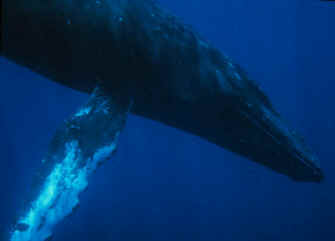
 Rattus norvegicus (Long Evans rat): Rodents are
the most commonly used animals in both behavioral and biomedical experiments
(see Besselsen's
Biology of Rodents for a detailed discussion of why this is the case). Long
Evans rats are also known as the hooded or piebald rat, because of their
distinctive coloration. Rats are not well known for their auditory
capabilities and for a while it was believed that rats were functionally deaf
(despite the fact they are nocturnal and show clear ear movements in response to
novel sounds). Rats can be trained to perform a wide range of behavioral
tasks including auditory learning tasks. Science is a cumulative process,
and because so much is now known about the biology and learning abilities of
rats, they are extremely useful research subjects. However, most scientists are
only interested in rats to the extent that the abilities of rats parallel the
abilities of people. I am currently conducting behavioral and
electrophysiological experiments with rats to try and better understand how
experience affects the neural processing of sounds. My experiments with
rats are designed such that they can be replicated in humans and other animals
to facilitate direct comparisons of auditory learning abilities across
species. These experiments will hopefully lead to new treatments that can
help people with learning and perceptual disabilities.
Rattus norvegicus (Long Evans rat): Rodents are
the most commonly used animals in both behavioral and biomedical experiments
(see Besselsen's
Biology of Rodents for a detailed discussion of why this is the case). Long
Evans rats are also known as the hooded or piebald rat, because of their
distinctive coloration. Rats are not well known for their auditory
capabilities and for a while it was believed that rats were functionally deaf
(despite the fact they are nocturnal and show clear ear movements in response to
novel sounds). Rats can be trained to perform a wide range of behavioral
tasks including auditory learning tasks. Science is a cumulative process,
and because so much is now known about the biology and learning abilities of
rats, they are extremely useful research subjects. However, most scientists are
only interested in rats to the extent that the abilities of rats parallel the
abilities of people. I am currently conducting behavioral and
electrophysiological experiments with rats to try and better understand how
experience affects the neural processing of sounds. My experiments with
rats are designed such that they can be replicated in humans and other animals
to facilitate direct comparisons of auditory learning abilities across
species. These experiments will hopefully lead to new treatments that can
help people with learning and perceptual disabilities.
 Megaptera novaeangliae (humpback whale): Humpback
whales are medium sized baleen whales (Mysticeti), about 10-16 m long.
The name humpback comes not from body shape, but rather from the characteristic
appearance of this whale as it submerges. Baleen is the name for the
flexible keratinous sieve-like structures that mysticetes possess in lieu of
teeth, through which they strain sea water to extract krill and small fishes
that make up the bulk of their diet. Until modern whaling reduced their
numbers, humpback whales ranged over all the oceans in both hemispheres.
The north Pacific humpback population, thought to have been around 15,000 prior
to whaling, had shrunk to about 1000 in 1966 when it was protected by
international agreement. Although there is a single worldwide species,
humpback whales have their own genus, Megaptera (meaning large wings),
because of several distinctive anatomical characteristics, notably their long
pectoral fins which can reach lengths of up to 5 m. A second unusual
characteristic is that, on the tops and sides of their heads, humpbacks have
subregular arrays of protuberances known as tubercles. Each fleshy
tubercle is cup-shaped on top and contains a single hair (vibrissa) that is
covered by the tubercle for most of its length, with many nerves attached to its
base and sides. Apart from anatomy, humpbacks are distinctive because of their
exuberant behavior, such as fin slaps, tail slaps, and breaching, and because
of their "song." Conducting studies with humpback whales is
difficult because (1) they spend most of their lives underwater; (2) they are
too large to be kept in an enclosure for extended periods; (3) they travel large
distances on a yearly basis; (4) it is illegal to approach or conduct
experiments with humpback whales without a federal permit. Because of
these constraints, most studies of humpback whales are observational.
Humpback whales are unique in many ways and are especially interesting as
subjects of auditory learning and plasticity studies because the dynamic
features of their songs imply highly flexible auditory processing
abilities. My studies of humpback whales focus on how they use sound, and
on how hearing in humpbacks compares with hearing in other mammals.
Megaptera novaeangliae (humpback whale): Humpback
whales are medium sized baleen whales (Mysticeti), about 10-16 m long.
The name humpback comes not from body shape, but rather from the characteristic
appearance of this whale as it submerges. Baleen is the name for the
flexible keratinous sieve-like structures that mysticetes possess in lieu of
teeth, through which they strain sea water to extract krill and small fishes
that make up the bulk of their diet. Until modern whaling reduced their
numbers, humpback whales ranged over all the oceans in both hemispheres.
The north Pacific humpback population, thought to have been around 15,000 prior
to whaling, had shrunk to about 1000 in 1966 when it was protected by
international agreement. Although there is a single worldwide species,
humpback whales have their own genus, Megaptera (meaning large wings),
because of several distinctive anatomical characteristics, notably their long
pectoral fins which can reach lengths of up to 5 m. A second unusual
characteristic is that, on the tops and sides of their heads, humpbacks have
subregular arrays of protuberances known as tubercles. Each fleshy
tubercle is cup-shaped on top and contains a single hair (vibrissa) that is
covered by the tubercle for most of its length, with many nerves attached to its
base and sides. Apart from anatomy, humpbacks are distinctive because of their
exuberant behavior, such as fin slaps, tail slaps, and breaching, and because
of their "song." Conducting studies with humpback whales is
difficult because (1) they spend most of their lives underwater; (2) they are
too large to be kept in an enclosure for extended periods; (3) they travel large
distances on a yearly basis; (4) it is illegal to approach or conduct
experiments with humpback whales without a federal permit. Because of
these constraints, most studies of humpback whales are observational.
Humpback whales are unique in many ways and are especially interesting as
subjects of auditory learning and plasticity studies because the dynamic
features of their songs imply highly flexible auditory processing
abilities. My studies of humpback whales focus on how they use sound, and
on how hearing in humpbacks compares with hearing in other mammals.
